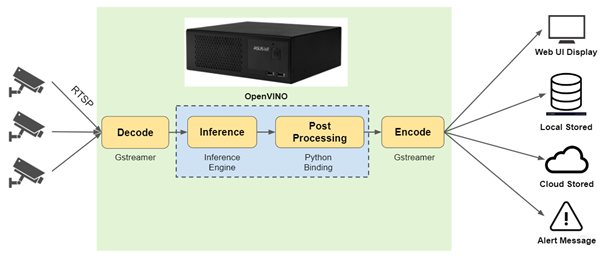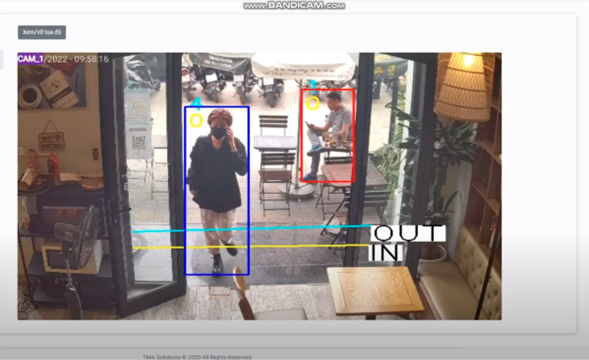
Application of OpenVINO for AI Solutions in Smart Stores
I. Introduction
In the era of Industry 4.0, the retail industry has undergone significant changes in its sales methods through digital transformation. In other words, digital transformation is the backbone contributing to the success of service-oriented businesses in the retail sector. Therefore, many retail enterprises are focusing on applying new technologies to accelerate their business and enhance the customer experience. From this, a new trend in managing and operating smart retail stores based on data has emerged, with the participation of diverse applications for the Internet of Things (IoT), Big Data and especially artificial intelligence (AI).

Image 1: Smart Store
In the field of AI, through smart camera applications such as people-counting, facial recognition, analysis of emotional expressions, shopping behaviors and object recognition, retail businesses can build a clear picture of customers who have visited or are currently at their stores or points of sale (PoS). This helps improve analysis, comparison, evaluation and the ability to capture changing trends to formulate effective business strategies. It also optimizes the service process, enhances the customer experience and attracts more frequent and loyal customers. Another significant challenge in implementing analytical systems is the cost and human resources for operation. With TMA Innovation's AI systems combined with IoT, almost everything is automated, eliminating the need for extensive data preparation and expert analysts or programmers to achieve results close to what is desired. Moreover, the data is updated 24/7 in real-time, replacing manual sampling systems conducted through surveys and manual counting by humans.
In addition, the deployment method is also a concern for businesses because it accounts for a significant portion of deployment costs. Currently, there are two main deployment methods: centralized processing and edge processing (processing at the network’s edge). Each has its own advantages in terms of processing speed, computing ability, ease of deployment, maintenance and system updates. Furthermore, in terms of infrastructure, ASUS IoT and Intel® are pioneers in providing a wide range of hardware solutions as well as software tools, which contribute to accelerating the progress of applications from the idea stage to deployment for businesses or end-users.
In this report, we will focus on presenting the Customer Traffic Analytics solution using the OpenVINO tool, optimized on ASUS IoT-Intel hardware. Specific applications include counting people in an area, counting people entering and exiting an area, tracking and creating heatmaps.
II. Technical Solution
The Customer Traffic Analytics system allows users to monitor multiple cameras simultaneously through the Real Time Streaming Protocol (RTSP). Subsequently, each image data stream is continuously processed and AI inference is performed. After processing, the result data is sent directly to the server for display on the web interface and stored in the data repository. If any abnormal violations occur according to user settings, alert signals are sent directly to the web system. Figure 2 provides an overview of the system being used.

Image 2: System Overview
Regarding inference processing, the AI model for recognizing people has been pre-trained and then converted and optimized for the format to adjust the model structure to increase processing speed on specialized hardware while maintaining equivalent accuracy. Subsequently, the model is inferred based on the OpenVINO inference engine, which is open-source software developed by Intel. The hardware we use is an ASUS IoT EBS-I10 with an Intel Core i5-9500TE CPU @ 2.20GHZ x6. Figure 3 outlines the process of deploying a deep learning model using OpenVINO.

Image 3: Deep Learning Model Deployment Process
Furthermore, OpenVINO supports pre-built models such as object detection, including people, faces, vehicles and so on, plus gender recognition, image classification, action recognition, text recognition and more. These models have been optimized and are compatible with OpenVINO, saving us a lot of time and effort in the deployment process.
III. Achieved Results
Below are some illustrative images of the functions of counting the flow of people and drawing heatmaps that have been applied in the TMA building area to serve the purpose of statistics, data analysis, and more effective management, and workforce coordination.

Image 4: People Counting Monitoring Screen

Image 5: People Entering/Exiting Counting Function

Image 6: Heatmap Display Function

Table 1:Comparison of Parameters for Some AI Models
IV. Conclusion
The comprehensive infrastructure support on both hardware and software platforms from ASUS IoT-Intel has provided a highly useful solution not only in the field of smart retail but also in many other areas where AI applications are still trending. This allows us to quickly realize and deploy these solutions to customers and businesses. However, we still need to continuously improve the models, enhance processing speed, and ensure system stability in a context where market demand is increasing day by day, and requirements are becoming more complex.
About TMA Innovation Company
TMA Innovation Company is a dynamic member of the esteemed TMA Technology Group with a rich legacy of over 25 years in research and delivering solutions to global corporations. Backed by a formidable team of over 4,000 engineers from TMA Solutions, they are committed to applying cutting-edge technologies for groundbreaking solutions. With substantial investments in Industry 4.0 technologies, their innovative products, infused with the latest advancements like Data Science, Artificial Intelligence (AI), Big Data, IoT, and Blockchain, cater to customers across borders, showcasing our dedication to excellence.
